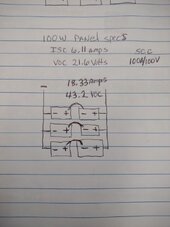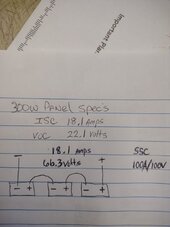Its a big wall of text and odd abbreviations for everything. Let me venture back in.
12.8V x 300Ah = 3840Wh
What watt hours are you talking about recording? The number produced in a day from solar?
If so then your daily solar (with no loads) should charge about 50% of your battery.
(2310Wh/ 3840Wh) = 60% if operating at 100% efficiency
The wire size depends on the volts, amps and distance. I cannot find how big your new inverter is going to be.
8Awg is small for a 100A SCC to battery.
900W solar / 14V charging = 64A so 8AWG wire not big enough. If you have enough, double it up.
View attachment 184394
How are you figuring 10 hours of solar?
Its more like 3.5h in December
1500W x 3.5h = 5250Wh

www.solarelectricityhandbook.com
View attachment 184397







